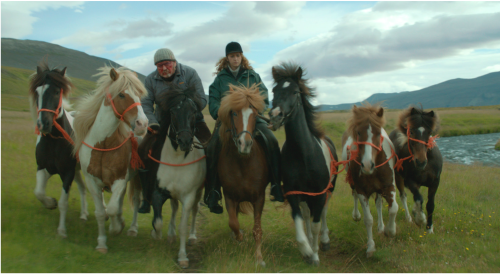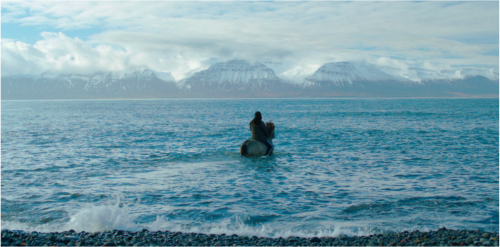Image above: Still from "Of Horses and Men." (Image from official press kit)
I imagine his window into the world of Iceland will be a revelation for most of us. Of the few things that I know about Iceland, one is Bjork, and the other is the existance of Icelandic horses which are unique and highly prized. They are small, (slightly larger than ponies) sturdy, with beautiful long thick manes and tails and a remarkably high gait which resembles a smooth fast trot, and is particular to the Icelandic breed. The ratio of horses to humans in Iceland is approximately one to four.
The film opens with a long languorous close up of the fur of a white horse. The camera moves caressingly along the horses body and finally focuses on the horses eye with a reflection of the man who is trying to saddle her. It is a moment of seduction as she first resists and then surrenders to the bridle. Kolbein (Ingvar Eggert Sigurósson), an intense fastidious man mounts her and strikes off across the countryside acutely aware of the figure he is cutting. He is smartly dressed and is he sits proudly erect on his beautifully groomed mare with her perfect gait. He is calling on Solveig (Charlotte Bøving), an attractive widow he is courting, who lives with her son and mother. She is clearly longing for him.
 Image above: Still from "Of Horses and Men." (Image from official press kit)
Image above: Still from "Of Horses and Men." (Image from official press kit)
While they are having lunch there is a parallel more lusty scenario occurring between Kolbein’s mare and Solveig’s big black stallion who is clearly “chomping at the bit” from his fenced in field. As Kolbein mounts up and rides off after lunch feeling full of himself, he is dismayed to see the black stallion breaking loose from his enclosure and galloping after him. Even more dismaying is when the mare stops and refuses to move, allowing the stallion to mount her while Kolbein, sitting astride her can do nothing. All of this is witnessed by seemingly everyone in the area who watch each other constantly through binoculars. He is thoroughly deflated and mortified. His reaction is shockingly violent.
This is but one of the interlocking stories of the individuals in the village. Each new story begins with a close up of a different horse’s eye reflecting the scene of the next tale. The connection between the inhabitants and their horses is integral to the fabric of their lives.This is a rugged country with rugged people. They live hardscrabble lives on a fairly elemental level with little use for social interactions apart from church, observing their neighbors through binoculars, and drinking strong liquor - usually swigged from a flask. These are not cocktails among friends. Emotions are completely unrevealed and unexpressed. Words are in short supply.
The various stories are incredibly primal and jarring in their intensity which is expressed in a matter of fact, non-verbal, deadpan manner. The characters simply do things which can be quite extreme without any warning or explanation. There does not appear to be any questioning or doubt. One man rides his horse into the ocean and they swim out to a Russian trawler which is leaving the port. He is desperate to obtain some strong vodka. The whole episode is desperate and the results are shocking and violent.
 Image above: Still from "Of Horses and Men." (Image from official press kit)
Image above: Still from "Of Horses and Men." (Image from official press kit)
A young man who joins the horse roundup and gets separated from the pack when his horse has gone lame in a snowstorm takes desperate measures to save himself at the expense of the horse. This is profoundly disturbing to me. But not to his compatriots who seem to be completely unfazed. There is a human sexual coupling which seems no less primal and urgent than that between the mare and the stallion. It is all very other worldly and viscerally powerful with the disparity between the horse population so wildly natural compared with the grimly repressed humans whose violent actions seem so shockingly uncivilized.
I suppose survival is the governing motivation and the horses are integral to the survival of these people. They are tribal in their way of life. Once a year they gather together and go out into the wilderness to round up the wild horses and bring them into a huge corral where all the populace gathers to select the horses which they will raise, train and sell to support themselves until the same time next year. It is this roundup which brings them all together. It is a fascinating look into a way of life in which the animal population looks a lot more intelligent, humane and beautiful than the human population.
by Belle McIntyre


